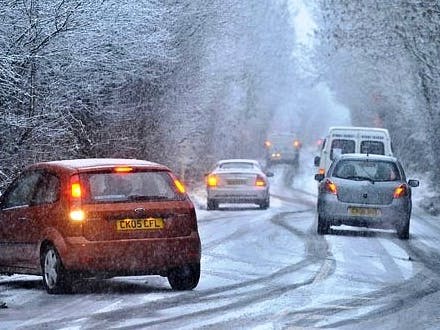Rationale
In the 2008-2009 winter there were 477 deaths due to the icy roads while in the 2009-2010 winter there were 458 deaths (http://icyroadsafety.com/fatalitystats.shtml). In New Jersey alone, the beginning of the 2014-2015 there were over 400 accident reported (hctv, January 19, 2015). An estimated 150,000 accident or more are due to the icy road conditions. Icy roads are formed when water from bridges and underpasses when the water melted from snow or rain pools in that area and freeze if the temperature is at 0 degrees celsius or below (http://www.maine.gov/bgs/riskmanage/tipofthemonth/tip20.htm). The air temperature that is under bridges can drop lower than the ground temperature, which is another reason icy roads on bridges is common. Although the southern states experience as much harsh climate, they experience more accidents and deaths than the northern states, such as New Jersey (http://icyroadsafety.com/fatalitystats.shtml). Our black ice detector is important because it can warn drivers when there is black ice nearby. Also it can have different application, for example, letting the salt trucks know where they should spread the salt instead of wasting salt. This is important because a black ice detection system for roadways could warn drivers when there is black ice nearby.Also it can have different applications, for example, letting the salt trucks know where they should spread the salt instead of wasting salt. It impacts society by potentially showing drivers that they should slow down due to the icy road in that area on a bridge or overpass. Therefore the number of accidents and deaths in the winter should drop.
Engineering Goals:The goal of this Research project is to connect a Vernier Motion Detector and a Vernier Surface Temperature Sensor to an Arduino Uno and programming it to detect black ice on roadways and activate an LED Array which can warn potential drivers.
Expected Outcomes:A Vernier Surface Temperature Sensor will detect when the temperature drops below 0 degrees celsius and the Arduino program will activate the Vernier Motion Detector which will be able to detect a decrease in distance between the roadway and sensor due to black ice. When this decrease in distance is detected, the Arduino program will light an LED which can warn drivers.
Procedures:First an Arduino Uno will be connected to a SparkFun Vernier Arduino Interface Shield through the pins. Next a Vernier Motion Detector will be connected to the Vernier Arduino Interface Shield through the digital 1 input. The Vernier Surface Temperature Sensor will connect to the Vernier Arduino Interface Shield through the analog 1 input. The Vernier Surface Temperature Sensor will be set so that it will touch the ground and the program on the arduino will be so that when the temperature sensor detects that the ground temperature was 0°C or below or the temperature requirement, in the given code, is met then it will activate the motion detector. The Vernier Motion Detector will be on a ring stand about 80 cm away from the ground. The Motion detector works by emitting an ultrasound wave that bounces off the surface below and then the code, that will later be uploaded on to the Arduino Uno, will calculate the distance based on the time it takes the wave to return back to the Vernier Motion Detector. If the temperature requirement met and the Vernier Motion Detector detects a decrease in distance then a LED Array is to be activated. This is done by connecting the Arduino to a SparkFun Badgerstick and LED array. When all the conditions are met the arduino will simply power the Badgerstick on which is coded to scroll the message "Black Ice"
To obtain the necessary code, a computer will be connected to the Arduino Uno via a USB to TTF cable. The code was created by modifying and combining the code for the Vernier Motion Detector and the code for the Vernier Surface Temperature Sensor
Codebender was used to code the Badgerstick and the tutorial can be found here



_ztBMuBhMHo.jpg?auto=compress%2Cformat&w=48&h=48&fit=fill&bg=ffffff)





_3u05Tpwasz.png?auto=compress%2Cformat&w=40&h=40&fit=fillmax&bg=fff&dpr=2)


Comments
Please log in or sign up to comment.